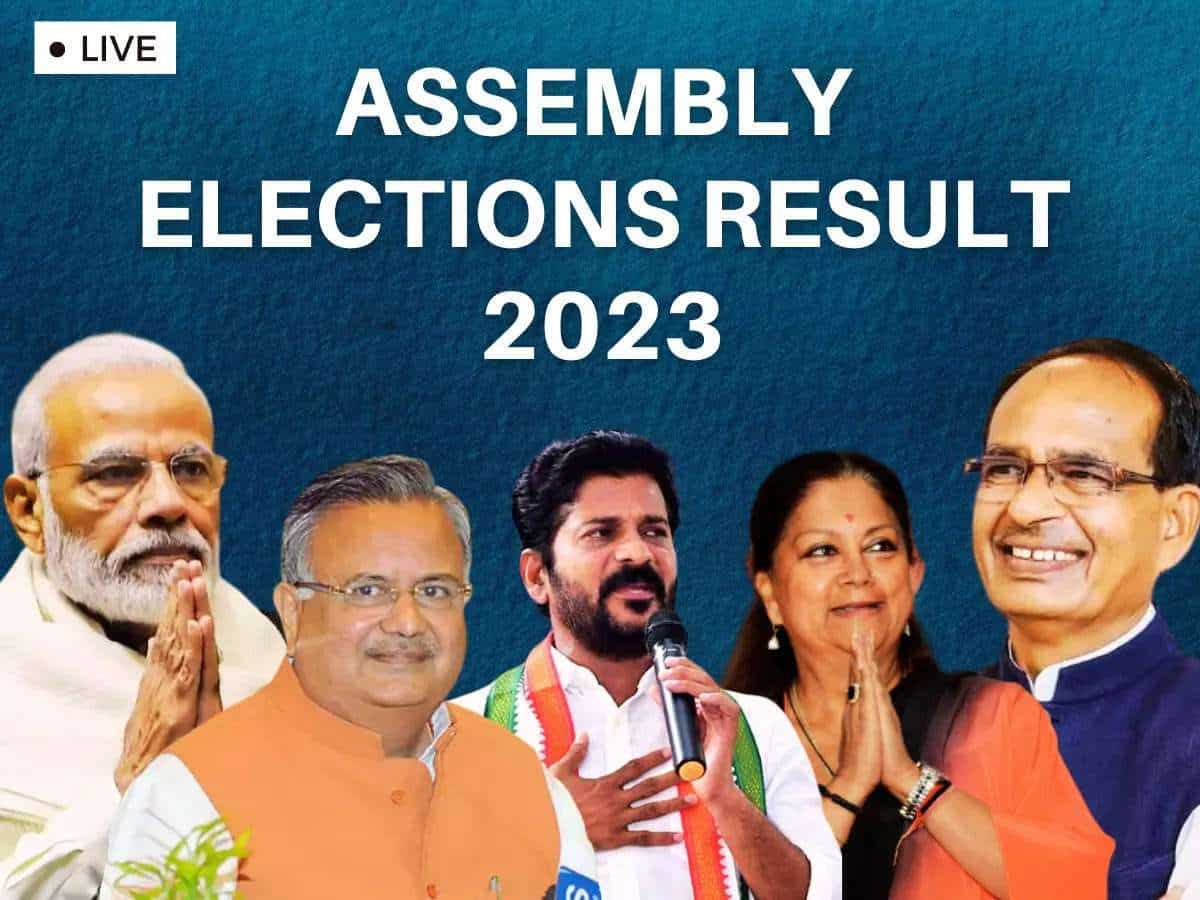BJP juggernaut and national politics
The 3-1 verdict between BJP and Congress set the stage for the road to the national polls in 2024. State and national contests often differ but several key indicators stand out from the results, which also have significant implications for Congress and opposition I.N.D.I.A alliance

In the final analysis, BJP has been further strengthened in pole position on the road to 2024. Congress has cause to celebrate with its Telangana resurgence but it has more questions than answers after these results
The 3-1 verdict between BJP and Congress in the state assembly elections set the stage for the road to the national polls in 2024. State and national contests often differ, of course, but several key indicators of the national mood stand out from the results in Madhya Pradesh, Rajasthan, Chhattisgarh and Telangana. The results also have significant implications for the Congress and opposition I.N.D.I.A alliance. Here are seven takeaways:
1) Brand Modi still impregnable, Congress Unable to Make Dents in Hindi Heartland: First and foremost, the results underline how Prime Minister Narendra Modi’s brand appeal retains its electoral potency, even in local contests. Remember that in Chhattisgarh, the BJP had no major pan-state leader of note. In both Madhya Pradesh and Rajasthan, the party specifically chose not to project a CM face, despite the presence of its traditional satraps, Vasundhara Raje and Shivraj Singh Chauhan.
2) BJP’s Core Voters and Party Machinery Remain Strong in Hindi Heartland: After two decades of incumbency in Madhya Pradesh, few gave BJP a chance even three months ago. This was equally true of Chhattisgarh where exit polls predicted a clear Congress edge. Yet, we have seen a BJP wave in MP and a saffron resurgence in Chhattisgarh.
These results showcase the inherent strengths of the BJP’s party’s cadre and its ability to reach the last mile with the voter. This matters in close contests.
Yet, elections are fundamentally also about momentum, narrative and emotion. In all three states (MP, Rajasthan and Chhattisgarh) the BJP faced significant internal issues. Yet, apt strategic moves by the party high command combining both ambition and aggression, detailed micro-level management and nimble course corrections as the campaign progressed enthused party cadres and galvanised political momentum in the party’s favour.
These elections showcased how the BJP adapted after its sweeping defeat in Karnataka reverses three months ago. In MP, for example, its gambit of fielding state party heavyweights who held national-level positions as ministers, party honchos or MPs succeeded. The BJP’s big guns were estimated to influence 79 MP seats. Of these BJP won 53 (18 more than last time).
MP was the original bastion of the Sangh from the 1960s onwards, long before even Gujarat. Now it has replicated the long-term electoral dominance of the party in Gujarat. The last time a Congress chief minister was in power in Bhopal (barring the 1 year interregnum of Kamal Nath in 2018), Manmohan Singh was yet to become prime minister, Narendra Modi was still a first-term CM in Gujarat and Barack Obama had not even become a US senator. An entire generation of voters has now grown up in the state having seen only one kind of government in power.
3) Voters Reject Mandal 2.0 and Caste Survey Idea: The runup to these assembly polls was animated by Rahul Gandhi’s call for a nationwide caste census. The opposition was betting big on this gambit as a way of cutting through the BJP’s Hindutva plank and fracturing the new Other Backwards Classes (OBC) base that has powered the party’s post-2014 victories in the Modi era.
This had limited impact on the ground. Almost one-third of MP’s 230 assembly seats, for example, are OBC-dominated. BJP was leading in 49 (20 more than last time) of 67 OBC-dominant seats in the state.
The lukewarm response to what many saw as a game-changing super weapon to combat the BJP’s poll juggernaut ahead of the 2024 polls indicates two things. First, the BJP continues to retain its OBC base. Second, people are rejecting the idea of wide-scale social disruption that a putative caste survey would surely herald. They seem to be choosing stability over social strife.
4) Tribal Surge for BJP: If there is a common social thread across the Hindi heartland states that went to polls, it is the clear tribal vote in favour of BJP. In Chhattisgarh, it led in 18 of 29 reserved tribal seats, in Madhya Pradesh 27 of 47 and in Rajasthan 11 of 25. In all three states, this tribal surge reverses the traditional voting pattern in these reserved seats – which last time was overwhelmingly in favour of Congress.
The appointment of Draupadi Murmu as the first person from a tribal community as India’s President is only the most visible of the BJP’s political overtures to tribal communities. A significant and underrated aspect of the BJP’s national victories in 2014 and 2019 were its advances in tribal regions. In 2019, for instance, it won 31 of 47 reserved ST seats nationally, up from 26 in 2014.
These results show that the BJP has consolidated its gains in tribal areas.
5) Muslim Consolidation Behind Congress, Issues for I.N.D.I.A Alliance: The Telangana verdict indicates a Muslim-consolidation behind Congress, away from regional parties. The shift of minority votes from BRS to Congress in Telangana repeats a pattern we saw in Karnataka earlier this year, where significant numbers of Muslim voters shifted from JDS to Congress as well. The BRS won only 18 of 39 Muslim-significant seats (down 12 from last time). Significantly, Asaduddin Owaisi’s party, AIMIM, only managed to win 3 seats (down 4 from 2018).
SP’s Akhilesh Yadav in UP and Trinamool Congress’s Mamata Banerjee in West Bengal will be watching this development closely. The minority vote has historically been an important bulwark of their electoral support base. A stronger Congress would directly threaten this core constituency for both parties. This would make them more wary of the prospect of a resurgent Congress in their backyards since that would directly threaten their social matrix.
Equally, a Congress that couldn’t regain Madhya Pradesh despite two decades of anti-incumbency and lost a totem pole chief minister in Chhattisgarh – apart from the loss in Rajasthan – emerges diminished from this contest in the Hindi heartland. This would reduce its influence or bargaining power in the I.N.D.I.A. alliance and its claim to a greater share of seats in many states where regional opposition parties are dominant.
6) Congress’s Telangana Win Shows North-South Divide in Indian Politics: The revival of the Congress in Telangana resurrects a core party bastion that had simply crumbled away in the aftermath of the new state’s formation in 2014. After the party’s Karnataka sweep earlier this year, the Telangana surge hands the Congress a second southern state, with a strong economic and financial base.
Like Karnataka, the Congress benefitted from a strong local leadership in Telangana. And it hugely benefitted from defections by many leaders who began to see it as a viable challenger in Hyderabad after the Karnataka victory. The party’s Telangana campaign essentially followed the same template as Karnataka and voters moved to it after it became clear that it was a serious challenger to the status quo.
Essentially, if the BJP remains numero uno in North India, the Congress has now rebuilt a significant part of its older base in south India. This will have implications for several key national debates, including delimitation which will come up soon after the 2024 Lok Sabha polls.
7) Women Voters Have Changed the Game: These elections have once again underscored the crucial role of the Mahila factor. In MP, for instance 18.3 lakh women voters cast their ballots, 2% more than last time. Women ‘labharthees’ clearly played a pivotal role in the BJP’s resurgence, driven by new welfare measures like the ‘Ladli Behna’ [Beloved Sister] scheme that put money directly in their pockets.
Women voters have been crucial to the BJP’s poll advances since 2014 in north India, on the back of welfare schemes and last-mile delivery with direct-benefit-transfers. Their rise has been a game-changer overturning traditional politics. The higher turnout of women voters is also intrinsically linked to the creation of a new ‘labharthee’ class’ and the rise of a new kind of competitive welfare politics. This trend is here to stay. As these elections showed, no major party can afford to ignore this.
In the final analysis, the BJP has been further strengthened in pole position on the road to 2024. The Congress has cause to celebrate with its Telangana resurgence, for sure. But instead of coming out with its tail up after an electoral contest that was billed as a semi-final before the big national contest, it has more questions than answers after these results. So does the I.N.D.I.A. alliance.











